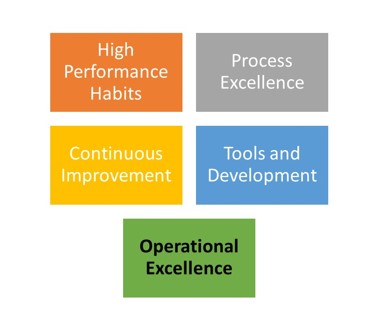Excellence then, is not an act, but a habit. – Aristotle
Healthy competition in an industry is always to be welcomed. From an economic perspective, customers know that they have options that will supply them their desired product or service, at the quality and price that they desire. Companies cannot afford to be complacent, or else they will lose the business that sustains them. Operational Excellence is the tool that keeps an organization on edge, and consistently challenging itself to satisfy its customer.
 Ongoing improvement in an organization is the result of the integration of High Performance Habits, Process Excellence, Continuous Improvement and the associated Tools and Development Processes. Continuous deliberate action is the driver of success. Patience and feedback are critical to sustaining this critical improvement loop, which will drive the organization to success. These are the underlying tenets of Operational Excellence.
Ongoing improvement in an organization is the result of the integration of High Performance Habits, Process Excellence, Continuous Improvement and the associated Tools and Development Processes. Continuous deliberate action is the driver of success. Patience and feedback are critical to sustaining this critical improvement loop, which will drive the organization to success. These are the underlying tenets of Operational Excellence.
With the objective of satisfying customers in sight, while boosting the morale of employees Operational Excellence will be achieved. As competition is heightened, operational excellence becomes gamified, and with the target objective being to achieve a high operational standard. Other similar entities, aiming to keep up, may or may not opt to emulate these operational standard as industrial best practices. The ultimate result is a raising of the standard of all players involved.
Business has always had as its primary objective, the need to be profitable. The achievement of the objective is what has been evolving over time. With Operational Excellence as a tool profitability is achieved in a holistic fashion and trickles down from leadership to the operational arms of the business.
Strategic Activities, CapEx, Accounting, Customer Satisfaction, Supply Chain Management, and Human Resource Management are all factored into the attainment of the organization’s greatest version. With a critical focus on processes and structures are the critical pathway forward is achieved.
The attainment of Operational Excellence requires an organization to have a bold vision, which is then strategically embedded into the operational fabric of the organization. High Performance Teams facilitate the execution of this vision via continuously implementing standards and optimizing or eliminating defunct ones.
The execution of Operational Excellence starts with visual representations of the organization’s process flows via methods such as value stream mapping. Value stream maps are ideal starting points for identifying quality critical system components in the organization’s operations. Once identified, a suitable reaction plan to process variations is suggested.
System measurement for facilitating target and actual conditions will facilitate process monitoring, coupled with system management. Where necessary, via processes such as kaizens, the operational system should be pushed to its optimal point. The aim is to always drive the organization towards excellence and achievement benchmark status in the overall industry. Healthy competition is generated, as persons challenge themselves to be better.
The tools for facilitating change are varied, and appropriate risk management will ensure that the associated returns on investment are facilitated. Operational Excellence brings more than profitability, it will generate a pride of workmanship, and a general ownership across the organization. Knowing that one is working to the best standards generates human satisfaction, which is what we are all seeking as we too become our greatest versions.
